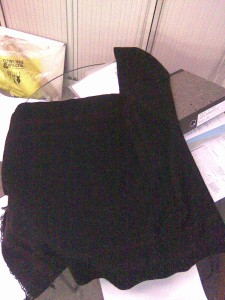 A friend (you may have heard me talking of her before) lives, breathes and loves Yohji Yamamoto’s designs. And she looks amazing in everything she wears.
A friend (you may have heard me talking of her before) lives, breathes and loves Yohji Yamamoto’s designs. And she looks amazing in everything she wears.
She recently returned from Hong Kong with a latest purchase that I couldn’t help but grab off her shoulders and photograph. It is a blurry image, and not well composed. But think of it as an image taken in a desperate need to get to know this garment.
It is, simply put, a wide and long scarf with a very plain hood attached to one side half way along the longest side. The image shows the scarf folded in half. The material is woven, not knitted; a fine cloth with some weight, but not too much.
That’s it. Nothing complicated or confusing. And yet, when worn, it looks magical.
BDW
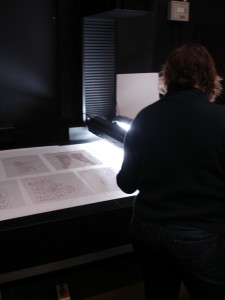 My friend Rosie is researching the eighteenth century mantua that I have raved about for ages in this blog and which you won’t see for a while yet. Patience, our dear readers, patience.
My friend Rosie is researching the eighteenth century mantua that I have raved about for ages in this blog and which you won’t see for a while yet. Patience, our dear readers, patience.
Rosie is a meticulous researcher, and I have learnt so much from working with her and being around her. Her understanding and insights into the dress, eighteenth century embroidery and cloth weaving grows daily.
In Rosie’s hands, embroidery is an art. I have seen her 3-D embroidery for an art installation, and it was captivating. Leaves, embroidered in deep greens, unfurled off the bodice of a gown, curling and twisting, reaching out into space.
The image highlights some of the acetates Rosie has created of the mantua’s bodice. On these acetates is drawn every section of embroidery – where the colour shifts in hue, any damaged areas, indications of any change of embroiderer’s personal style (the number of people who worked on the dress is numerous going by the different styles of stitching).
With these acetates, Rosie slowly unpicks the history of this fine gown. Each stitch reveals something. The scans will help her reveal even more.
It really is enlightening to see the story unfold.
BDW
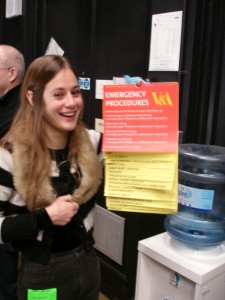 At the V & A Museum the other day, helping a friend with the scanning of an eighteenth century mantua for her MA research. And then we saw this and it made us laugh.
At the V & A Museum the other day, helping a friend with the scanning of an eighteenth century mantua for her MA research. And then we saw this and it made us laugh.
The dos and the don’ts of the V & A. It was quite a read. It was all there in tab form, ready for us to defend the nation’s prizes. Shonagh (the woman in the photo) and I could now tackle any terrorist, art thief or blackmailer with the flick of a wrist.
BDW
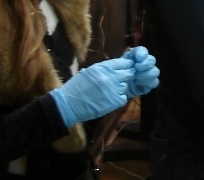 It did feel a little like a violation. Here we were, students of dress curation and history, gingerly coaxing a 1740s (or thereabouts) court mantua into place for each scan of her delicate fibres wearing blue latex gloves.
It did feel a little like a violation. Here we were, students of dress curation and history, gingerly coaxing a 1740s (or thereabouts) court mantua into place for each scan of her delicate fibres wearing blue latex gloves.
Ivory silk satin, shimmering under bright, industrial lights, the field in which a fantasia of flora invades the senses. You could feel the heat of the sun warming explosions of blossoms glinting and swaying in the breeze somewhere in never-never land.
Cornucopia stitched in gold and silver thread, offering up blousy, heavy bulbs ready to spring into life. Chrysanthemums and anenomes growing out of the same branches, reaching for the sky in bright reds and blues, violets and greens.
As we moved the gown for each scan, we had to pick up the minute pieces of the gold and silver thread as they dropped off, the material and embroidery so fragile with age.
And here we were, using blue latex gloves to touch this beauty? Wrong, all wrong.
BDW
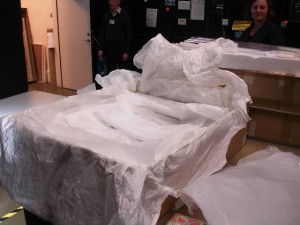 My friend researching the mantua asked me to help take it to the Victoria and Albert Museum a few Saturdays ago to have the old gal scanned. Although I had to hand in my MA thesis a week later, there are just some things you have to be involved in, and I wasn’t going to miss this opportunity for the world.
My friend researching the mantua asked me to help take it to the Victoria and Albert Museum a few Saturdays ago to have the old gal scanned. Although I had to hand in my MA thesis a week later, there are just some things you have to be involved in, and I wasn’t going to miss this opportunity for the world.
I can’t show you a picture of the old lady. She’s a bit publicity shy at present. And my friend would kill me if I showed images to the world, as the research is not yet published. The old gal’s reintroduction into society will have to wait a bit.
In the meantime, here’s a photo of the box we used to carry the grand old lady to the museum for the day to have her photo taken. It’s quite pretty too.
BDW
 O, the stories this old mantua could tell. Who embroidered it? Did they suffer hardships to make this? The fineness of the embroidery, and the length of time it would have taken (presumably a team of people) to stitch this is astounding. But it does raise that hoary old question about what lengths people will go to for beauty.
O, the stories this old mantua could tell. Who embroidered it? Did they suffer hardships to make this? The fineness of the embroidery, and the length of time it would have taken (presumably a team of people) to stitch this is astounding. But it does raise that hoary old question about what lengths people will go to for beauty.
The social and personal histories of such garments are often thought-provoking in the lack of detail available, and can weigh heavy on the conscience.
The same quandaries can be asked of the ‘fast fashion’ blighting the high street of cities around the world. It has been revealed that Uzbekistan closes many of its primary schools
during the cotton picking season, and children are forced to work in the fields. The cotton is whisked off to another country to be made up into the £2.99 t-shirt many people buy on the British high street.
Sometimes, the ‘white gold’ is not worth the weight.
BDW
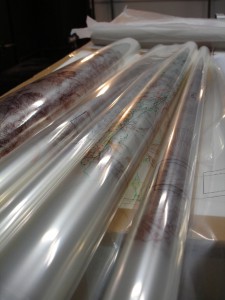 I am in love with a dress. A big, billowing dress whose beauty is unsurpassed.
I am in love with a dress. A big, billowing dress whose beauty is unsurpassed.
I should really call her a gown, for that is what she is. An eighteenth century court mantua. The mantua was a style fashionable around the early/mid 1700s (with variations on the theme well into the late eighteenth century), with skirts that spread out each side, reaching as wide as your arms outstretched. A train (length dependent on how aristocratic you were) usually fell from the waist of a tightly fitted bodice.
A friend has been researching this fine old lady for over three years now, and the secrets have slowly unravelled to reveal one of the most exquisite examples of court mantua you would care to meet.
Each time I meet my friend, I hear of her latest discoveries. About the owner of the dress (was it worn at court? How much did it cost?). How old is it? Probably 1739-42, although, like most dress history, we work with a lot of assumptions and guestimates.
About the silk (380 silk thread count per square inch). About the fact that no loom in the UK can make silk this fine today. About the time it took to embroider this (approximately 150 hours to stitch a 10cm by 10cm square). Given this is a mantua and we are talking acreage of material, the thousands of hours it would have taken to create is awesome.
About the fact that there are still pen marks from where the design was ‘pounced’ on to the silk, and that the embroidery wasn’t completed.
BDW
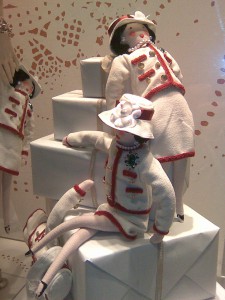 These fine ladies of Chanel were sitting in the window of the store on Old Bond Street, London. Given the obsessive knitter’s penchant for knitting bears and making dolls, I thought it was a bit kizmit-y to see these ladies waving from the other side of the world.
These fine ladies of Chanel were sitting in the window of the store on Old Bond Street, London. Given the obsessive knitter’s penchant for knitting bears and making dolls, I thought it was a bit kizmit-y to see these ladies waving from the other side of the world.
The ladies of Chanel prove it ain’t what you wear, it’s the way that you wear it.
BDW
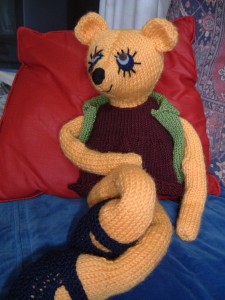 Twizzle Apricot, as BDW has named her, has been causing strife amongst the other critters, so she has gone with her best friend to live up country. TA considers herself a fashion leader and tends to look down on those who do not share her sense of the sartorial. Maybe, in her new home, she will learn to keep her opinions to herself and become handy round the farm.
Twizzle Apricot, as BDW has named her, has been causing strife amongst the other critters, so she has gone with her best friend to live up country. TA considers herself a fashion leader and tends to look down on those who do not share her sense of the sartorial. Maybe, in her new home, she will learn to keep her opinions to herself and become handy round the farm.
Can you see her rounding up sheep…. She has never met a wooly four-legged creature and doesn’t know she is made of wool. OOooooh.
MBW
I didn’t have daughters, I had sons, but that didn’t mean I wouldn’t make long legged dolls and toys for them. Forty years ago I made the first long legged dolls for their cousins in England. My sons were not yet born and I was in a hurry. Now I’m back making long legged toys again, and it’s fun, and they keep reappearing. Any excuse will do.
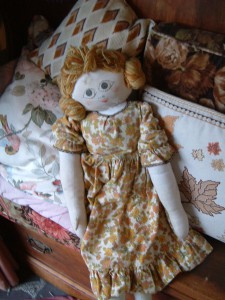
Long lost in the cupboard.
When I was making the long legged dolls in the seventies, I worked by hand or machine in fabrics, felts and yarns. Recently we found one of the fabric dolls in a cupboard. She had somehow hidden herself away for thirty or more years. Photographed for posterity’s sake, she was bidden to the bin. Her dress is torn and shredded, ready to be reused as part of a patchwork quilt, and yet she has refused to be destroyed. She’s hiding once more, in her underwear, in a box in the spare room.
At the moment I am experimenting with pointy-nosed creatures that look more like meercats than bears, dogs or rabbits. Each comes with their own sense of being. I started off knitting them in body pieces and am working towards knitting them in the round as I want to avoid the stitching up process… like I said, I’m in a hurry. I like to shape the body as I am knitting, a decrease here and an increase there. As I feel moved to make changes, the critter shapes itself.
MBW
 A friend (you may have heard me talking of her before) lives, breathes and loves Yohji Yamamoto’s designs. And she looks amazing in everything she wears.
A friend (you may have heard me talking of her before) lives, breathes and loves Yohji Yamamoto’s designs. And she looks amazing in everything she wears.







